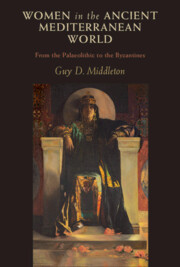Book contents
- Women in the Ancient Mediterranean World
- Women in the Ancient Mediterranean World
- Copyright page
- Dedication
- Epigraph
- Contents
- Preface
- Acknowledgements
- Timeline
- Historical Contexts
- Introduction
- Part I The Deep Past
- Part II The Bronze Age
- Part III The Iron Age
- 12 Naunakhte
- 13 Herse
- 14 Pkpupes
- 15 Atossa
- 16 The Princess of Vix
- 17 Aristonice
- 18 Neaira
- 19 Phanostrate
- Part IV The Hellenistic Worlds
- Part V The Age of Empire
- Notes
- Select Bibliography
- Index
16 - The Princess of Vix
from Part III - The Iron Age
Published online by Cambridge University Press: 19 January 2023
- Women in the Ancient Mediterranean World
- Women in the Ancient Mediterranean World
- Copyright page
- Dedication
- Epigraph
- Contents
- Preface
- Acknowledgements
- Timeline
- Historical Contexts
- Introduction
- Part I The Deep Past
- Part II The Bronze Age
- Part III The Iron Age
- 12 Naunakhte
- 13 Herse
- 14 Pkpupes
- 15 Atossa
- 16 The Princess of Vix
- 17 Aristonice
- 18 Neaira
- 19 Phanostrate
- Part IV The Hellenistic Worlds
- Part V The Age of Empire
- Notes
- Select Bibliography
- Index
Summary
Marc Van de Mieroop has written that ‘human agency … defines the limits of the Mediterranean world’.1 Thus whilst not Mediterranean in a geographical sense, Iron Age Vix, in Burgundy, France, was certainly connected to the Mediterranean and to its diverse peoples and cultures. Vix is located strategically at the southern end of the northwest-flowing Seine and the northern reaches of the Saone/Rhone that flows south to the sea at Arles, near Marseilles, the site of a major Greek colony from 600 bc.2 It is around this time that archaeologists note the adoption by many Celtic elites of the accoutrements of Greek drinking culture – the symposion – with its attendant cups and craters. Greek and Etruscan goods are found in greater numbers and Vix had contacts with both cultures and quite possibly Greek and Etruscan craftspeople were at work in Celtic lands.3 Celtic mercenaries were active in the Mediterranean and Celtic people were intermarrying with Etruscans and possibly Greeks too.4
- Type
- Chapter
- Information
- Women in the Ancient Mediterranean WorldFrom the Palaeolithic to the Byzantines, pp. 138 - 142Publisher: Cambridge University PressPrint publication year: 2023

